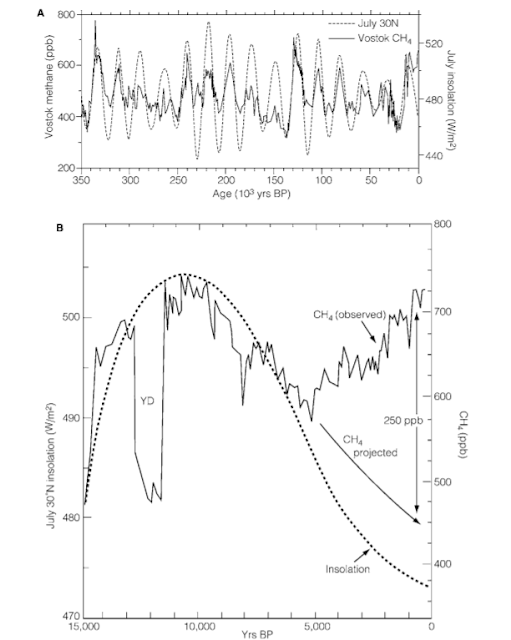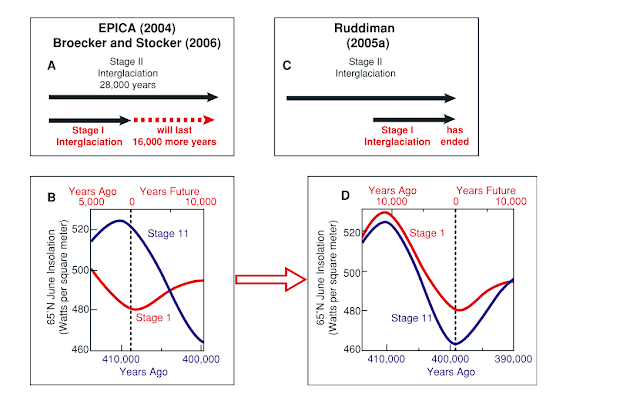The start of the Anthropocene and Ruddiman's hypothesis
Humanity, defined broadly, goes back 4.5 million years. Homo sapiens, the modern human, evolved 195.000 years ago. Since the beginning of agricultural practices 11.000 years ago, the global human population has expanded exponentially (fig. 1). So, why do we think that humans only started to affect the greenhouse gas emissions since 1750, the start of the industrial revolution?
In fact, the start of the Anthropocene is a hotly debated topic. When introduced in the year 2000, Crutzen and Stoermer set the start of the Anthropocene at 1800 AD. The first scientist who challenged this starting point was William Ruddiman in 2003. Ruddiman examined the natural CO2 and CH4 cycle of past interglaciations in the Vostok ice record and compared this cycle with the trend of the Holocene, the current interglaciation. He noticed a rise in emissions for CO2 and CH4 about 8000 and 5000 years ago respectively. He argued that this rise in GHG concentrations can be linked to the clearance and irrigation for expanding agriculture: an early human effect on the atmospheric composition. These activities caused a rise just big enough to stop the next glaciation, according to Ruddiman.
Although he received a lot of support for his theory (e.g. Crucifix and Berger, 2006; Rohling et al., 2010; Kaplan et al., 2010), not everyone agreed with Ruddiman's hypothesis.
The main criticism of Ruddiman was that he used interglacials (MIS 5, 7 and 9) as anologues for the Holocene, which might not have been most similar in their orbital parameters to the Holocene. They (EPICA Community members, 2004, Siegenthaler et al., 2005; Joos et al., 2004; Schmidt et al., 2004) suggested that MIS11 is a better analogue, due to the eccentricity values. Using this analogue, they argued that the current interglacial could last another 16.000 years and that the climate without human intervention would be very similar to the current climate. This theory suggests that the rise in methane 5000 years ago would be in the range of natural forcing.
In 2007, Ruddiman made a comeback with a paper in which he refutes this criticism and other arguments against his theory. He admitted that MIS11 can be a good analogue for the Holocene, but that the EPICA Community members aligned the two interglaciations in a wrong way. They presented the present-day insolation minimum against the stage 11 insolation maximum. It would make more sense, according to Ruddiman, to align the present insolation minimum against the first insolation minimum of MIS11. This way, also the analogue MIS11 would support his theory.
But Professor Viv Jones showed in a lecture of 20 October this 2011-study, modelling the methane emissions by climate and wetland area simulations. They concluded that these fluctuations capture the late Holocene methane variability and thus reject Ruddiman's hypothesis.
So, to date, there is still no general agreement on the start date of the Anthropocene. I asked Mark Maslin, paleoclimate professor at UCL who argues himself for a 1610 or 1964 AD start of the Anthropocene, what he thought about Ruddiman's hypothesis. His answer was that he could not falsify Ruddiman's theory - and therefore Ruddiman might actually be right.
The big question maybe is - does it matter? Yes, it does. By defining the Anthropocene, we will define natural variability and therefore the safe operating space to which we should return. It is therefore of fundamental importance to recognize what our natural environment is, before we can return to it.
 |
| Figure 1 | Estimates of the world population since 10,000 BC. Keep an eye on the non-lineair axis before 1927 AD. The human population seemed to have grown since the beginning of this graph. |
In fact, the start of the Anthropocene is a hotly debated topic. When introduced in the year 2000, Crutzen and Stoermer set the start of the Anthropocene at 1800 AD. The first scientist who challenged this starting point was William Ruddiman in 2003. Ruddiman examined the natural CO2 and CH4 cycle of past interglaciations in the Vostok ice record and compared this cycle with the trend of the Holocene, the current interglaciation. He noticed a rise in emissions for CO2 and CH4 about 8000 and 5000 years ago respectively. He argued that this rise in GHG concentrations can be linked to the clearance and irrigation for expanding agriculture: an early human effect on the atmospheric composition. These activities caused a rise just big enough to stop the next glaciation, according to Ruddiman.
 |
| Figure 2 | A) Comparison of the July insolation with the Vostok methane record over 350 kyr. B) Comparison of the July insolation with the GRIP methane record. The methane levels according to the insolation cycle are projected for the last 5000 years. |
The main criticism of Ruddiman was that he used interglacials (MIS 5, 7 and 9) as anologues for the Holocene, which might not have been most similar in their orbital parameters to the Holocene. They (EPICA Community members, 2004, Siegenthaler et al., 2005; Joos et al., 2004; Schmidt et al., 2004) suggested that MIS11 is a better analogue, due to the eccentricity values. Using this analogue, they argued that the current interglacial could last another 16.000 years and that the climate without human intervention would be very similar to the current climate. This theory suggests that the rise in methane 5000 years ago would be in the range of natural forcing.
In 2007, Ruddiman made a comeback with a paper in which he refutes this criticism and other arguments against his theory. He admitted that MIS11 can be a good analogue for the Holocene, but that the EPICA Community members aligned the two interglaciations in a wrong way. They presented the present-day insolation minimum against the stage 11 insolation maximum. It would make more sense, according to Ruddiman, to align the present insolation minimum against the first insolation minimum of MIS11. This way, also the analogue MIS11 would support his theory.
 |
| Figure 3 | Alignment of stage 11 and stage 1 (present interglaciation) according to EPICA Community members (B) and Ruddiman (D). The alignment in B shows that stage 11 was still in the middle of the interglaciation and therefore, the present interglaciation should last 16,000 years longer (A). Ruddiman moved the axis shown in B for stage 11 to the right (to circa 400.000 years ago) so that the two insolation minimums are aligned. This alignment shows that the present interglaciation should have ended (C). |
So, to date, there is still no general agreement on the start date of the Anthropocene. I asked Mark Maslin, paleoclimate professor at UCL who argues himself for a 1610 or 1964 AD start of the Anthropocene, what he thought about Ruddiman's hypothesis. His answer was that he could not falsify Ruddiman's theory - and therefore Ruddiman might actually be right.
The big question maybe is - does it matter? Yes, it does. By defining the Anthropocene, we will define natural variability and therefore the safe operating space to which we should return. It is therefore of fundamental importance to recognize what our natural environment is, before we can return to it.


Comments
Post a Comment